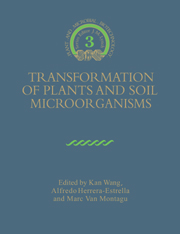Book contents
- Frontmatter
- Contents
- List of Contributors
- Series Preface
- Preface
- Acknowledgements
- Abbreviations and Terms
- Part I Transformation of Soil Microorganisms
- Part II Transformation of Cereal Crops
- 5 Rice Transformation: Methods and Applications
- 6 Maize
- 7 Barley, Wheat, Oat and Other Small-Grain Cereal Crops
- Part III Transformation of Industrially Important Crops
- Index
7 - Barley, Wheat, Oat and Other Small-Grain Cereal Crops
Published online by Cambridge University Press: 04 August 2010
- Frontmatter
- Contents
- List of Contributors
- Series Preface
- Preface
- Acknowledgements
- Abbreviations and Terms
- Part I Transformation of Soil Microorganisms
- Part II Transformation of Cereal Crops
- 5 Rice Transformation: Methods and Applications
- 6 Maize
- 7 Barley, Wheat, Oat and Other Small-Grain Cereal Crops
- Part III Transformation of Industrially Important Crops
- Index
Summary
Introduction
The most important crop plants of the world belong to the monocotyledonous grasses. From the perspective of genetically transforming these successful outdoors plants with new genes, they have properties in common. The tissues of these grasses lack what is called the wound response – the characteristic of the cells at a site of physical damage to proliferate and form calloid protective tissue – the cereal tissue rather seals the wound site by lignification and sclerification of the cells.
This alternative strategy in reaction to wounding seems to be the basis of the recalcitrance of cereal plants to the manipulations of the experimentalist. The two most commonly used gene transfer techniques utilize either the capability of Agrobacterium to mate with plants or the capacity of a naked plant cell (protoplast), where DNA can be introduced by physical means, to regenerate its cell wall, start to divide and finally to differentiate into a mature plant. Neither of these methods functions easily for the cereal grasses. Agrobacteria deliver their transferred DNA into cells at a wound site – destined to deteriorate. Protoplasts of cereal plants have been very hard to regenerate and especially to retain their capacity to differentiate after regeneration. This situation has led to the development of alternative, often very imaginative, gene transfer techniques. The literature of cereal transformation is littered with reports of exotic methods that mostly have given ambiguous results and are very hard to repeat.
- Type
- Chapter
- Information
- Transformation of Plants and Soil Microorganisms , pp. 81 - 98Publisher: Cambridge University PressPrint publication year: 1995



